
Following three years of intensive research, an international team of researchers have compiled the first ever "World Cybercrime Index," which identifies the globe's key cybercrime hotspots by ranking the most significant sources of cybercrime at a national level.
The Index, published in the journal PLOS ONE, shows that a relatively small number of countries house the greatest cybercriminal threat. Russia tops the list, followed by Ukraine, China, the U.S., Nigeria, and Romania. The UK comes in at number eight.
Co-author of the study, Dr. Miranda Bruce from the University of Oxford and UNSW Canberra said the study will enable the public and private sectors to focus their resources on key cybercrime hubs and spend less time and funds on cybercrime countermeasures in countries where the problem is not as significant.
"The research that underpins the Index will help remove the veil of anonymity around cybercriminal offenders, and we hope that it will aid the fight against the growing threat of profit-driven cybercrime," Dr. Bruce said.
"We now have a deeper understanding of the geography of cybercrime, and how different countries specialize in different types of cybercrime."
"By continuing to collect this data, we'll be able to monitor the emergence of any new hotspots and it is possible early interventions could be made in at-risk countries before a serious cybercrime problem even develops."

The data that underpins the Index was gathered through a survey of 92 leading cybercrime experts from around the world who are involved in cybercrime intelligence gathering and investigations. The survey asked the experts to consider five major categories of cybercrime, nominate the countries that they consider to be the most significant sources of each of these types of cybercrime, and then rank each country according to the impact, professionalism, and technical skill of its cybercriminals.
Co-author Associate Professor Jonathan Lusthaus, from the University of Oxford's Department of Sociology and Oxford School of Global and Area Studies, said cybercrime has largely been an invisible phenomenon because offenders often mask their physical locations by hiding behind fake profiles and technical protections.
"Due to the illicit and anonymous nature of their activities, cybercriminals cannot be easily accessed or reliably surveyed. They are actively hiding. If you try to use technical data to map their location, you will also fail, as cybercriminals bounce their attacks around internet infrastructure across the world. The best means we have to draw a picture of where these offenders are actually located is to survey those whose job it is to track these people," Dr. Lusthaus said.
Co-author of the study, Professor Federico Varese from Sciences Po in France, said the World Cybercrime Index is the first step in a broader aim to understand the local dimensions of cybercrime production across the world.
"We are hoping to expand the study so that we can determine whether national characteristics like educational attainment, internet penetration, GDP or levels of corruption are associated with cybercrime. Many people think that cybercrime is global and fluid, but this study supports the view that, much like forms of organized crime, it is embedded within particular contexts," Professor Varese said.
The World Cybercrime Index has been developed as a joint partnership between the University of Oxford and UNSW.
More information: Mapping the global geography of cybercrime with the World Cybercrime Index, PLoS ONE (2024). DOI: 10.1371/journal.pone.0297312
Citation: World-first 'Cybercrime Index' ranks countries by cybercrime threat level (2024, April 10) retrieved 10 April 2024 from https://techxplore.com/news/2024-04-world-cybercrime-index-countries-threat.html
This document is subject to copyright. Apart from any fair dealing for the purpose of private study or research, no part may be reproduced without the written permission. The content is provided for information purposes only.
